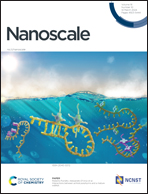A double-crack structure for bionic wearable strain sensors with ultra-high sensitivity and a wide sensing range†
Abstract
Flexible strain sensors are crucial in fully monitoring human motion, and they should have a wide sensing range and ultra-high sensitivity. Herein, inspired by lyriform organs, a flexible strain sensor based on the double-crack structure is designed. An MXene layer and an Au layer with cracks are constructed on both sides of the insulated polydimethylsiloxane (PDMS) film, forming an equivalent parallel circuit that guarantees the integrity of the conductive path under a large strain. The rapid disconnection of the crack junctions causes a significant change in the resistance value. Due to the effect of cracks on the conductive path, the sensitivity of the sensor is largely improved. Benefiting from the double-crack structure, the as-obtained sensor shows ultra-high sensitivity (maximum gauge factor of up to 14 373.6), a wide working range (up to 21%), a fast response time (183 ms) and excellent dynamical stability (almost no performance loss after 1000 stretching cycles and different frequency cycles). In practical applications, the sensor is applied to different parts of the human body to sense the deformation of the skin, demonstrating its great potential application value in human physiological detection and the human–machine interaction. This study can provide new ideas for preparing high-performance flexible strain sensors.

- This article is part of the themed collection: 2025 Chinese New Year Collection


 Please wait while we load your content...
Please wait while we load your content...